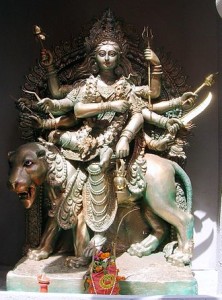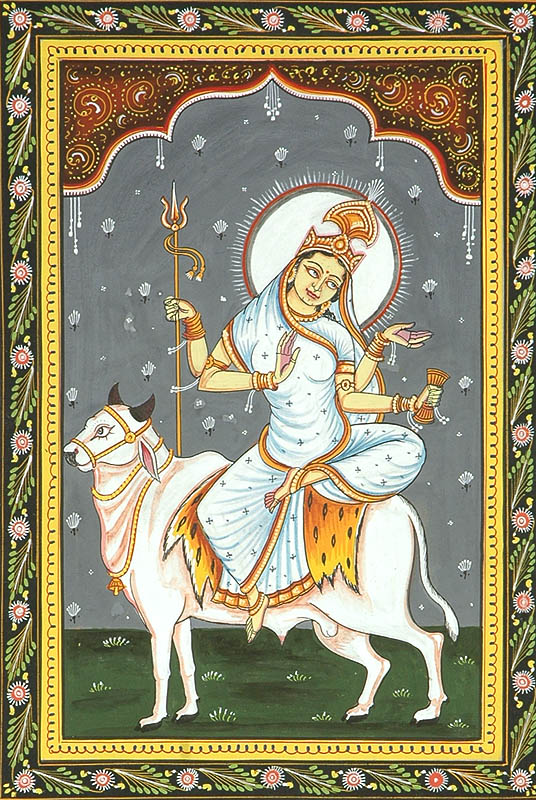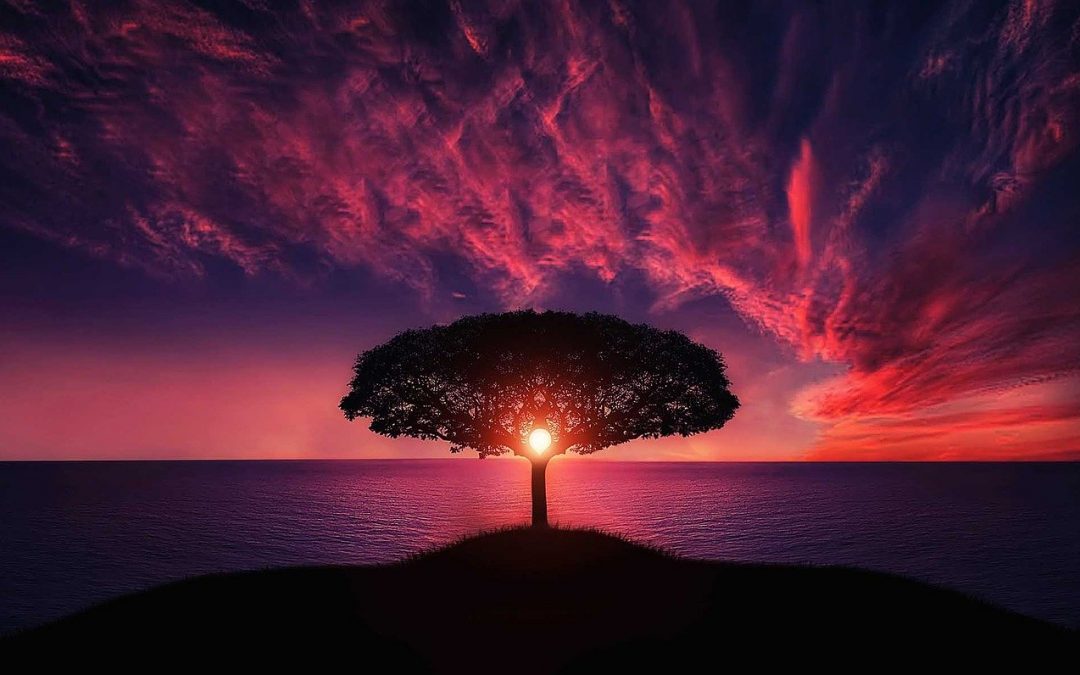
by Somya Devi | May 21, 2020 | Uncategorized
New Moon May 2020
The new moon cycle begins in Taurus on May 22nd at 10:38 AM PDT, in the Vedic nakshatra of Krittika, “the cutter.” Taurus is a feminine earth sign ruled by Venus, and Venus joins the Sun and Moon in Taurus on this dark moon tonight along with Mercury. Both Mars and Jupiter cast their aspects here, while Saturn, Jupiter, and Venus are all in retrograde motion.
Taurus Cycle
A Taurus cycle compels us to get into our physical bodies, focus on things close at hand, and find the simple beauty that comes from nature, foods, and pleasurable activities. Amidst the pandemic, the stars are supportive this month to help us focus on family and the simple pleasures around the home. Fitting with the season, this is a good cycle to work on gardening and to beautify your indoor and outdoor as well as inner landscapes.
On a spiritual level, Taurus helps us to forge ahead (sometimes with a stubborn, “bull-headedness”) in our chosen direction … it can sometimes be hard to change directions, however, so it is important to set some intentions and orient yourself properly on this dark moon night before the cycle begins. Mars’ aspect onto the new Moon adds some firepower to the mix, while Jupiter’s glance adds a breeze of wisdom and grace.
Krittika Nakshatra
Krittika means “the cutter,” and this star helps us to cut away that which we do not need. It is ruled by Agni, fire personified, which also helps us to cut and burn away the excesses that we may have been carrying. On this new Moon night it’s a great time to cut or clear away anything that is weighing you down or getting in your way. Literally cutting plants, hedges, foods, or hair are good activities we perform that also symbolize some of the inner cutting we must do on our vasanas (negative tendencies) and unnecessary attachments.
This star is symbolized by a razor, axe, or flame. There is also a feminine nurturing quality to this star, as it relates with Lord Kartikeyya who was suckled by six pleiades (this nakshatra is the cluster of seven stars known as the pleiades). This is the birthstar of Mata Amritanandamayi Devi (“Amma”), a great saint who is known for her power to cut through negativities and also nurture endlessly as the divine Mother.
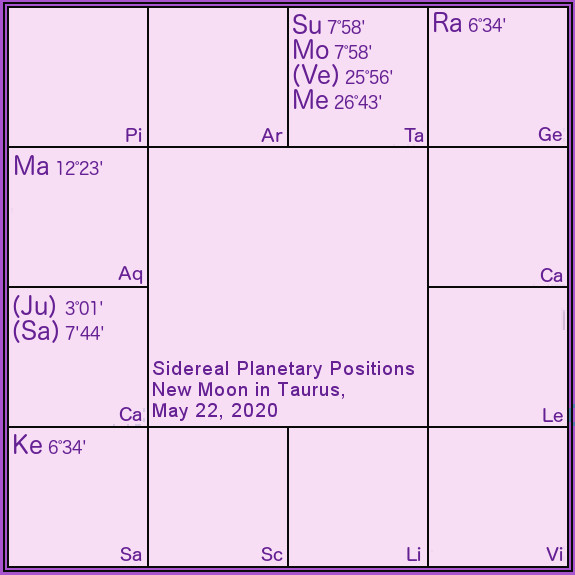
Three Retrograde Planets: Venus, Jupiter and Saturn
Venus, Saturn, and Jupiter are all traveling in apparent retrograde motion at the moment, giving them strength and an inward-oriented power. When Venus is retrograde we have an enhanced ability to reflect upon our relationships. This can include doing some work on your patterns (and creating better ones), as well as re-examining old relationships or reconnecting with people from your past. It also lends us the ability to examine our relationships with sensory pleasures in general, perhaps redefining our relationships with food, drink, or substance, or unearthing some of our creative energy that has been left dormant.
With Jupiter retrograde we must look deeply at the philosophies, creeds, and spiritual beliefs that guide us. It is a good time to reconnect with scripture or teachers, and really examine yourself inwardly for how your belief structures are working and supporting you. It can be a great time to re-commit to spiritual practice, as Jupiter is getting closer to earth and brighter in the sky during the first half of this retrograde cycle (the whole cycle is from May 14th through September 12th).
Under retrograde Saturn we examine our long-term goals, our work and the ways we commit to support ourselves, and the very structures under which we live. You may find this period is an opportunity to restructure or redefine the work you do in the world, or your understanding of what are the most important things that you are working for. Saturn retrograde can also teach us more about self-control and self-discipline, but also the need to let go of external attachments and rely more on our inner strength. Meditation is one of the greatest remedies for Saturn.
Saturn and Covid
Saturn is currently strong in his own sign as well as strong due to his retrograde transit, and, in Capricorn, is a large part of the force that is restructuring the outside world during this Covid crisis. He brings restriction and contraction, and in Capricorn, forces us to examine the structures that support us, particularly as a society. This retrograde transit could bring some relief but it asks us to choose new directions when he begins to move forward again, surrendering more to the greater good, rather than trying to hold onto systems of power that have been failing.
Personal readings are available here.
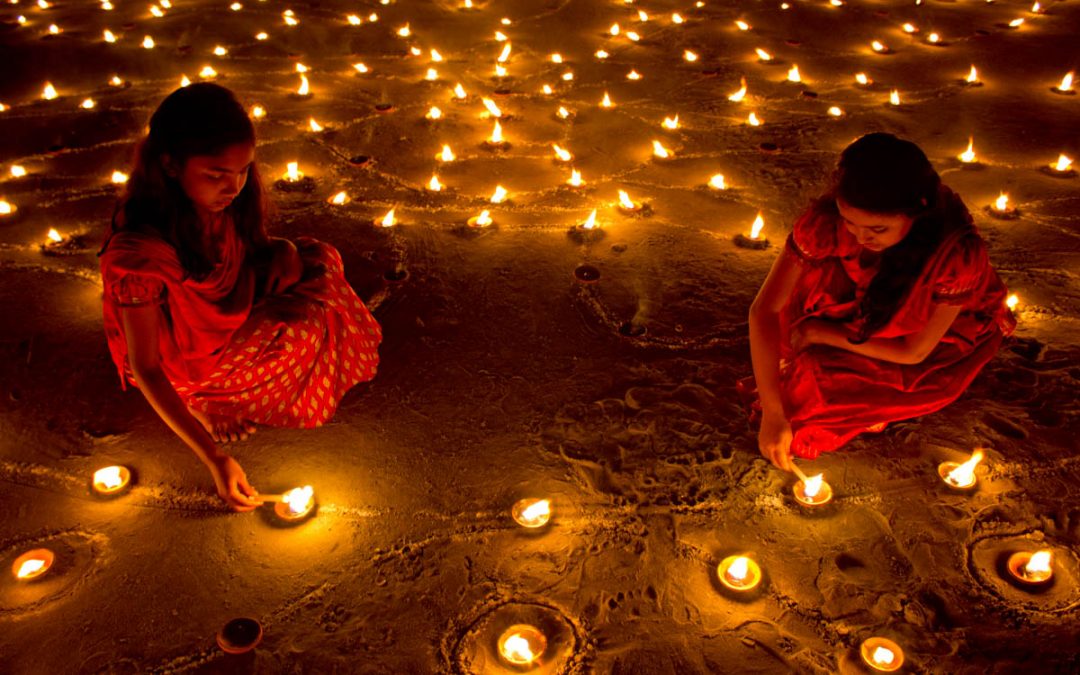
by Somya Devi | Oct 24, 2019 | Astrology, Conjunctions, Holy Days, Planets Changing Signs
The Sun and Moon will join at 10° sidereal Libra this Sunday night, October 24th, at 8:39 pm PDT. This Dark Moon night commemorates the Hindu holiday of Diwali, the festival of lights. October 27th will actually be the third but main night of celebration of this festival, which begins on Dhanteras on October 25th.
Libra cycle
The New Moon in Libra will begin a Libra cycle, compelling us to find balance, harmony, beauty, and compromise. Venus will have just left his own sign of Libra, a couple of hours before the New Moon, but has been strong there the last several weeks and during most of the Amavasya dark Moon phase leading up to the exact New Moon moment.
One thing to note about the Libra cycle is that the Sun is considered neecha or naturally debilitated there, so self-care becomes especially important during a Libra cycle. Since the Sun relates to our sense of strength and vitality, and Libra is the sign of compromising (or over-compromising) with others, it is possible that our own strength becomes diminished as we elevate the level of energy and attention we give to those around us. Caring for others doesn’t necessarily translate to depleted health, but it can when we overemphasize the outer world and others to the point of neglecting our own self-care.
This is a very important time of year to nourish ourselves, and our inner light, as the outer light is descending. At the beginning of this cycle, set an intention for a mindful self-care routine this month. Light some candles (or turn on your electronic ones) for Diwali on the Dark Moon night, and if possible, take some time each day to offer yourself some time to nourish and honor your personal light. Self-care practices can include yoga, meditation, chanting, art, or self-abhyangha (oil massage). You can also make some herbal tea to nourish yourself during this vata (cold and dry) season.
Swati Nakshatra
This New Moon joins the Sun in Swati nakshatra, a nakshatra that is also known to add to vata conditions, as it gives the power to scatter like the wind, so be aware of restlessness this Dark Moon night. It is ruled by Lord Vayu, wind embodied, and is symbolized by a young plant blowing in the wind, both flexible and strong amidst it. It can be translated as the “priest” or the “sword” and carries hidden spiritual potential from its association with Rahu. The male buffalo is the animal symbol for Swati nakshatra.
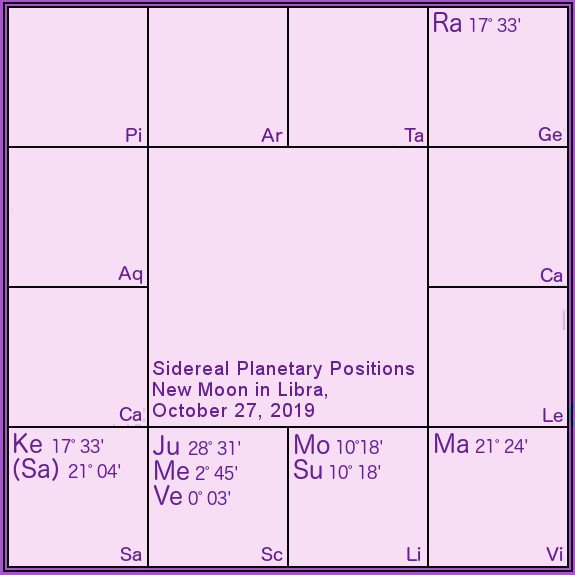
Venus, Jupiter and Mercury
These three benefic planets will be traveling together in sidereal Scorpio from October 26th through November 4th, when Jupiter transits into Sagittarius. The conjunction of these three planets creates a Sarasvati yoga during certain times of day, which could offer auspicious muhurtas (moments) for initiating artistic, educational or spiritual activities. If you were born with a Sarasvati yoga in your natal chart, you may find it more activated during these times.
Jupiter in Sagittarius
On November 4th, we will experience a major movement in the cosmos, as Jupiter transits from Scorpio into Sagittarius. Because the outer planets move slower, they spend longer in each sign, so this transit is important because it will take effect for over a year while Jupiter travels through his own sign. Generally that brings strength to a planet, but with the current conjunction with Saturn and Ketu, also in Sagittarius, we could see an intensification of strange and radical ideologies vying for their place on the world stage.
Dhanteras and Diwali
On the new Moon of the Hindu month of Ashwin (this month), we celebrate Diwali, the festival of lights. The festival begins this year on Friday, October 25th (North America), on the 13th waning Moon phase of the previous cycle. This day is known as Dhanteras, or Dhanvantari Tryodashi, the celebration of the birth of Lord Dhanvantari, the father of Ayurvedic medicine. If you practice any healing tradition, especially Ayurveda, this is a good day to give thanks and call in auspicious blessings to your healing path or practice.
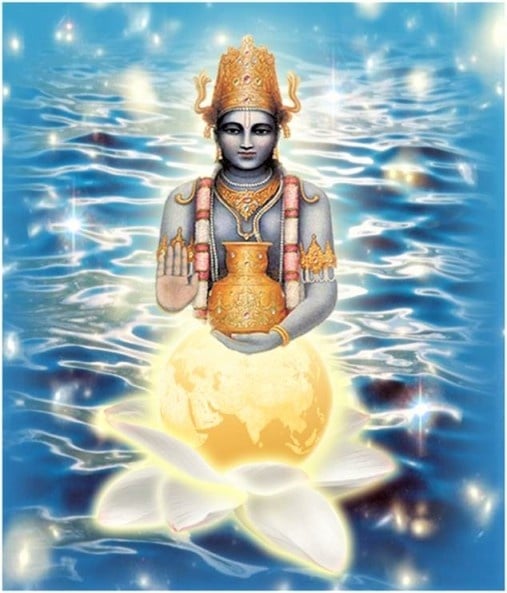
Diwali is strongly associated with the Goddess Laxmi, and is a powerful time to connect with her, calling in her blessings for both material and spiritual prosperity. Dhanteras commemorates the day that Lakshmi emerged from the milk ocean in Vedic lore. In India, it is customary to purchase metals on this day — anything from jewelry to new statues to kitchenware (excluding iron), especially silver and gold — as a part of celebrating Lakshmi and calling in more prosperity. The metals can then be offered to your altar and will absorb and amplify the benefits of worship performed over the few days of Diwali.
We celebrate Diwali while the days are getting noticeably shorter and darker, and it is a time to invite more light into our lives, our hearts, and our world. This festival celebrates the victory of light over darkness, which is something to rejoice in and have faith in, even if we can’t outwardly observe it sometimes. Creating positive vibrations internally is the best way to begin growing and spreading them externally.
Diwali also commemorates Lord Ram’s and Sita’s return from exile after fourteen years (a story from the Ramayana). Lord Ram embodies the highest qualities of dharma, devotion, compassion, courage, and leadership. Diwali is also the start of a new lunar cycle, so it’s a great time to go within and summon these qualities to awaken and live through you.
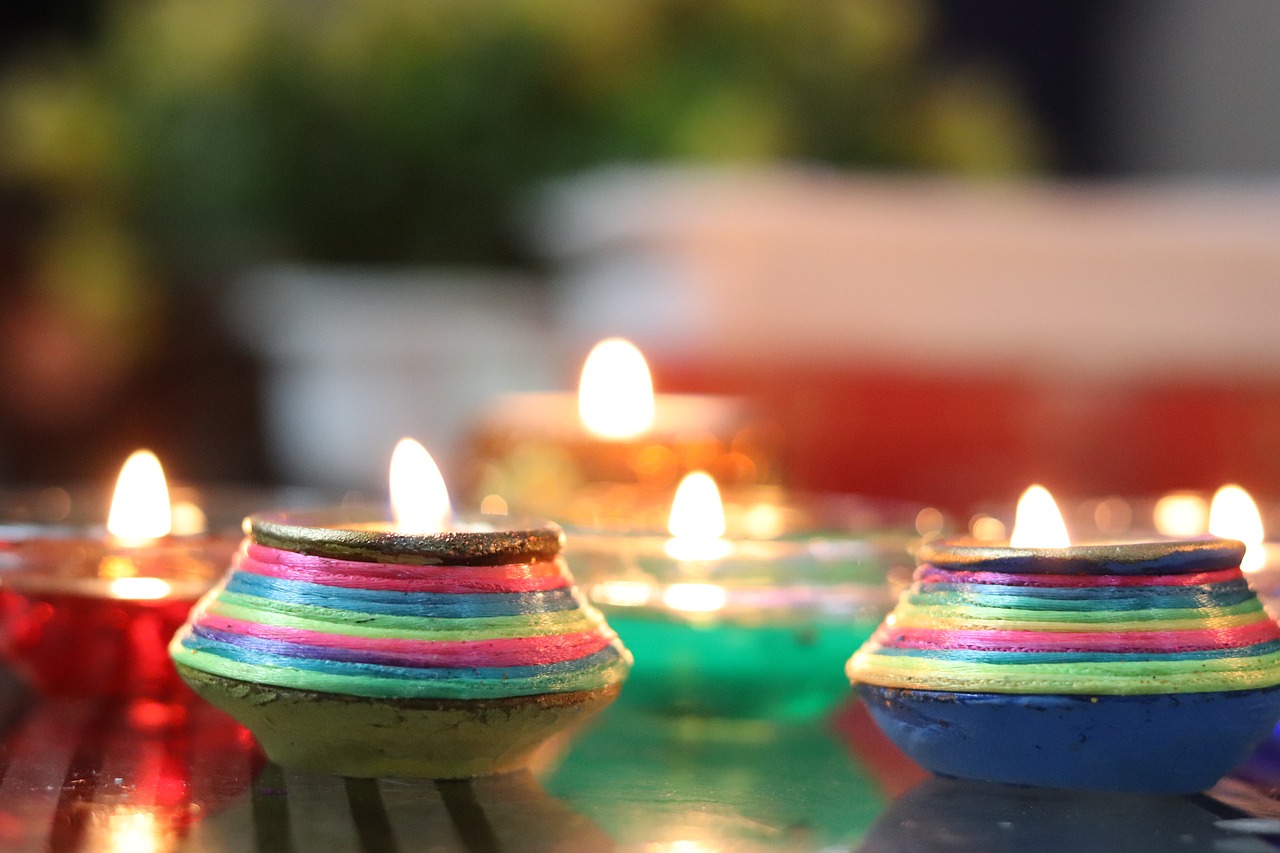 Diwali (also seen as Divali, Deepawali or Deepavali) comes from the Sanskrit words deepa (light) and avali (row). It is traditional to light candles throughout Diwali (opt for electronic tea lights if you’re in a fire danger zone!), inviting the highest light into our homes and lives. The candles are lit to remind us of the inner divine light in us all. Though one flame can be used to light many others, it is not diminished by sharing its power of illumination. We can pray for the peace and happiness of all beings, and each one’s awareness of their inner light.
Diwali (also seen as Divali, Deepawali or Deepavali) comes from the Sanskrit words deepa (light) and avali (row). It is traditional to light candles throughout Diwali (opt for electronic tea lights if you’re in a fire danger zone!), inviting the highest light into our homes and lives. The candles are lit to remind us of the inner divine light in us all. Though one flame can be used to light many others, it is not diminished by sharing its power of illumination. We can pray for the peace and happiness of all beings, and each one’s awareness of their inner light.
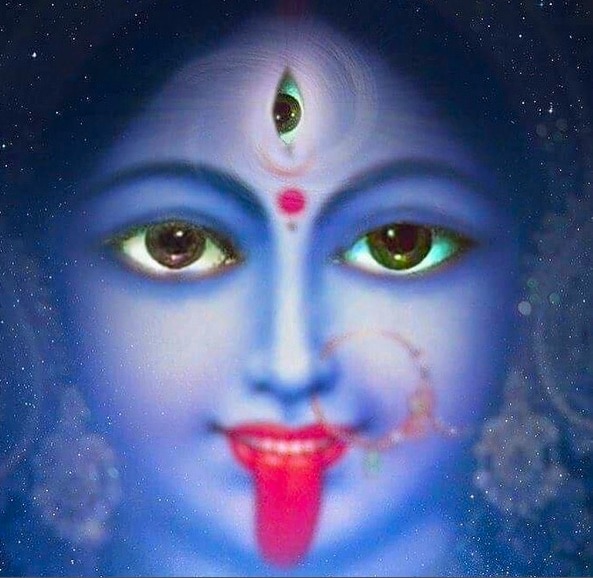
by Somya Devi | Sep 27, 2019 | Astrology, Events, Holy Days
Maha Navaratri 2019 is upon us! In this important Hindu holiday, we celebrate the Goddess through “the great nine nights” (nav = nine, ratri = night). This festival will run from September 29th through October 8th, the first ten days of this new lunar cycle. Goddess, Devi, Shakti, Durga, Divine Mother—the many names and forms all represent the dynamic and fluid feminine power that enlivens all of existence.
She is the creatrix, the warrioress, the nurturer, the purifyer, the protector. While she’s in the innocent and fertile maiden so is she the wise and learned crone. Both the nurturing mother, and the one who gives “tough love.” The impassioned lover, the devoted bhakta, the disciplined yogini. We see Goddess appear through us in innumerable manifestations. Through her many forms she teaches us and offers us countless blessings–love, compassion, courage, learning, discipline, surrender, success, enlightenment, and bliss. This festival is a time for celebrating the supreme feminine power in all her glory, and the many blessings she bestows upon us.
As with most Hindu celebrations, this festival correlates with the lunar calendar, and thus begins on the first day of the waxing Moon after the New Moon of September 28th. The celebration is through the “nine nights” of September 29th through October 7th, and into the tenth morning known as Vijayadashami, “the day of victory.” Worship during Navaratri is most generally dedicated to Goddess in the form of Durga, the demon-slayer, but there is much nuance and variation to practice and forms of celebration throughout India. Above all, Navaratri is a community celebration of the Divine Mother, and the love, abundance and protection she gives.
There are many Navaratri celebrations throughout the year, but the fall-time Navaratri is the most widely celebrated, and is thus called Maha Navaratri – “the great nine nights”. It correlates with the time of the harvest, a time to give thanks for the abundance of the year’s work. Grains and crops are often offered to Devi as part of the celebrations. Ritualistic worship (puja) typically occurs in homes and temples throughout the nine nights and into the tenth morning of celebration.
The Many Forms of Goddess
Durga-Lakshmi-Sarasvati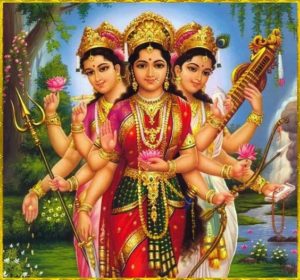
In Kerala and other places in India, the first three nights of worship are dedicated to Durga (the invincible), the next three to Lakshmi (Goddess of prosperity), and the final three to Sarasvati (Goddess of learning). Durga, also celebrated as her incarnation of Kali, helps us to destroy and remove the negative tendencies in our minds and hearts, freeing us from the obstructions to our spiritual and material pursuits. Lakshmi helps us to cultivate positive qualities like compassion and devotion, and leads us towards both spiritual and material prosperity. Sarasvati assists us in attaining knowledge and wisdom, through the illumination of our consciousness. She aids in awakening sattva, the quality of purity, and the flow of prana, the vital breath. After removing inner and outer obstacles and cultivating prosperity through virtuous qualities, our devotion, service, and practice help us to attain a state of peace, bliss, and oneness.
Sarasvati-Lakshmi-Kali/Durga
In the Kali Kula (Kali school of worship) in northeastern India, Sarasvati is worshiped on the first three nights, followed by Lakshmi on the next and then Kali/Durga on the last three. Sarasvati, Lakshmi, and Kali/Durga (Kali emerged from Durga) are also known as the consorts of Brahma, Vishnu, and Shiva. The Goddesses, therefore, provide the shakti to the cosmic processes of creation, preservation, and death (transformation), similar to their male counterparts. Consequently, worship in this manner is dedicated to the cycles of life and Mother nature, through birth, then sustenance, then death. Death is not a complete stop, but allows for the regeneration of energy into a new cycle once again.
9 Forms of Durga
Throughout India, the nine nights of Navaratri are often dedicated to 9 different incarnations of Durga, allowing the worship of many different aspects of Shakti in a gradual evolution. You can read the stories and significance of these 9 goddesses here, or a more a brief introduction, here:
“Daughter of the mountain”; creative energy, muladhara (root chakra), awakening; Awaken your connection with Goddess today or initiate a new venture, calling on Shailputri for new beginnings.
The ascetic; tapas, discipline, devotion, strength, wisdom, creative abundance; Good day for fasting and meditation, connection with svadhistana (sacral chakra).
Warrioress; protection, courage, grace, manipura (solar plexus); Destroy your internal obstacles by offering them to Chandraghanta.
Creatrix of the “cosmic egg”; strength, health, happiness, success, relationships; Connect with the vital Sun energy and the anahata (heart chakra) today.
“Mother of Skanda/Kartikeya”; motherly love, nourishment, protection, purity; Call on divine truth through the vishuddha (throat chakra), invoking Skandamata to lead you towards victory.
Warrioress who destroyed Mahishasura (the buffalo demon); victory, devotion, strength, removing obstacles; Meditate on these qualities of Goddess through the ajna chakra (third-eye) today.
“Dark/black night,” representing a fierce form of Durga/Kali; darkness, death, surrender, dissolution of pain; Connecting with the sahasrara (crown chakra), remember that Divine Mother offers love, compassion, and many blessings even in hard times. Even in the midst of apparent darkness, and helps us to go beyond the boundaries of the material body-mind and connect with spirit.
“Great white goddess”; detachment, purification, renewal, protection, virtue; Through detachment and devotion, we emerge purified, shining and radiant after surrendering in the dark night. Rejuvenative herbs and foods are good today.
Goddess of “siddhis”; magical, spiritual or mystic powers and blessings, fulfillment of desires, devotion, divine union; Invite Goddess to reveal her presence to you everywhere and in every moment.
Personal Practice Ideas for Navaratri
If possible, it is great to reduce our workload and gather with community at local temples or places of worship. We can also create a little time and space at home and conduct some personal practices to celebrate Goddess energy. Dive into your own heart to connect with the inner Goddess in the ways that resonate most with you! Here are some ideas to do at home or with a group throughout the nine nights of Navaratri:
Altar
Create a sacred space, a Durga altar, or a Goddess altar. Even if you already have one, you can refresh it in some way or rearrange it specifically for Navaratri. Include images or statues of the Goddess(es) you have a relationship with. This could be according to one of the groups of forms above.
Invocation
Even if you don’t have much time, dedicate at least a few minutes each day to connecting with the Divine Mother in front of your altar, calling her energy into your life and being.
Journal
Write in your journal about what qualities of Goddess you perceive and connect with. What aspects would you like to strengthen or to cultivate more deeply? Write any and all prayers and offer them to the form of Goddess that appeals to you.
Light
Offer light to illuminate Goddess’s power, helping her to shine more brightly into the world and your life. You can light a candle by the altar and keep it burning when you’re at home. You can even keep an electronic tealight on symbolically when you are away.
Flowers/Grains
Offer flowers or grains (even a small dish of dried rice) to celebrate Devi in the form of mother nature, fertility, the abundance of the harvest, and the cycle of life.
Offerings
Offer incense, bells, water, or food if you feel called, by placing it on the altar, or mentally offering it to Goddess throughout the day. You can also offer something symbolic of your own work or practice, whatever you have been cultivating for harvest through the year. In offering this you surrender the fruits of your efforts to the Divine Mother.
Fasting
Some people choose to fast in some variation, if this is something you have practiced before. This might include fasting during the day, fasting with only milk or fruit, or abstaining from alcohol and non-vegetarian foods during Navaratri.
Chanting
Chanting the Devi Mahatmyam, a verse to the Goddess, is a common practice during the nine-night festival. You can also chant another Goddess mantra or songs that are special to you and your relationship with Devi.
Jai Ma Durga!
Personal Vedic Astrology readings and forecasts are available Here.
Did you like Maha Navaratri 2019? Please Like, Comment and Share!
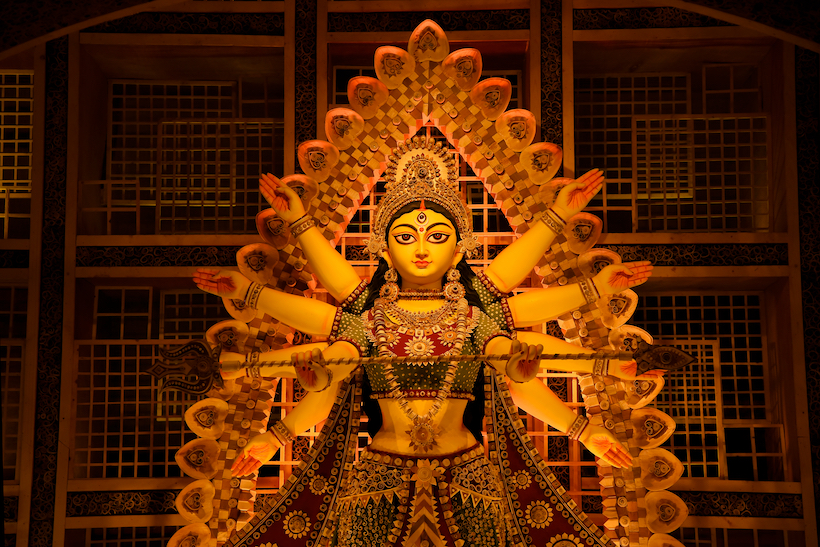
by Somya Devi | Sep 27, 2019 | Astrology, Conjunctions, Events, Holy Days, Planets Changing Signs
Tonight brings a dark Moon as the Moon joins the Sun in sidereal Virgo. Exact New Moon in Virgo will be at 11:26 am PT on Saturday, September 28th. This begins a Virgo cycle that will help us to connect with the earth, the feminine, and draw ourselves more inward as we enter the season of the Sun’s decent in the northern hemisphere.
Virgo Cycle
We’ve just passed the equinox on September 23rd, the time where night and day are of equal lengths, and we are now entering the yin season where the hours of darkness will exceed the hours of light. This first full lunar cycle begins in Virgo, a feminine earth sign, that encourages us to ground out some of the activity of summer and turn inwards as we come upon this darker season.
Virgo is also ruled by Mercury, the planet of the intellect, which will get us thinking about practicality and logistics this month. Have you planned your store for winter, getting together everything you need and tying up loose ends in the world before your period of inward attention and maybe even hybernation? Mercury is still technically joining the Sun and Moon in Virgo as we begin this cycle, but will be passing into Libra the next day. Venus and Mars also join in Virgo now, making our nights especially dark as these three stay close to the sun and only Jupiter and Saturn are visible. Venus remains debilitated in Virgo for just a few more days, until October 3rd.
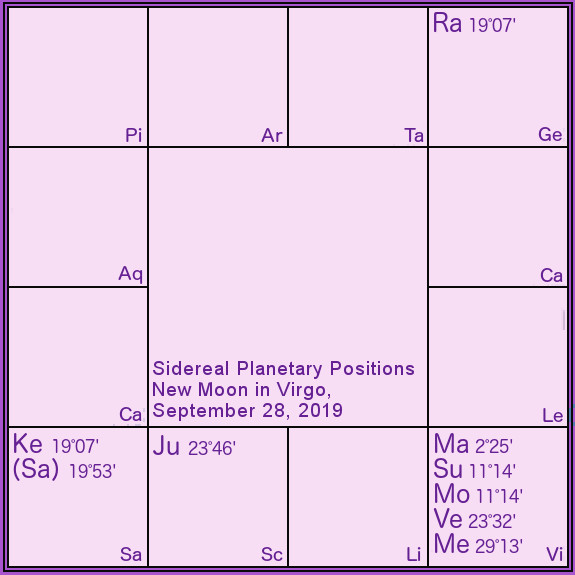
Hasta
This New Moon occurs with Sun and Moon in Hasta nakshatra, the sign of the hand. Hasta is a place that allows us to hone our skills, both manual and intellectual. It offers us a “craftiness,” whether literal, or of mind. This is a good time for getting into any hands-on work that requires dexterity, as well as for business dealings or other organization that requires tact and skill. Hasta is ruled by Savitar, the Sun God, while also linked to the Moon’s influence, and its animal is the female buffalo.
Maha Navaratri
The New Moon this month brings one of the largest Hindu festivals of the year, Maha Navaratri. Navaratri means “the nine nights,” and beginning with the first Moon phase after the dark Moon, the Goddess Devi is celebrated through many forms for the following nine nights and ten days. In North America Navaratri will be celebrated from September 29th through October 8th, with October 8th being the 10th day of Victory (an auspicious time for starting new endeavors, after 9 nights of worship). In some places Navaratri celebrates the goddess Durga in nine of her forms, while in other parts of India the festival commemorates Durga/Kali, Lakshmi, and Sarasvati for three nights each.
Devi is the creatrix, the warrioress, the nurturer, the purifyer, the protector. She can be found in the innocent and fertile maiden as well as the wise and learned crone. She is both the nurturing mother, and the one who gives “tough love.” The impassioned lover, the devoted bhakta, the disciplined yogini. We see Devi appear through us in innumerable manifestations. Through her many forms, she teaches us and offers us countless blessings–love, compassion, courage, learning, discipline, surrender, success, enlightenment, and bliss.
This festival is a time for honoring and celebrating the supreme feminine power in all her glory, and the many blessings she bestows upon us. Read more about Maha Navaratri 2019 here, and stay tuned for daily updates on how to connect with the many forms of the Goddess.
Kala Sarpa & Nodal Influences
This year’s festival could churn up even more internal difficulties than usual … offer them to the Goddess! We are currently under a Kala Sarpa cycle, with all planets to one side of the Rahu-Ketu axis, and will be in this alignment until October 6th. This can bring up more shadow energy and sticky spots than usual, especially if you are running a Rahu-Ketu dasha or have these planets prominently in your chart. It’s all the more reason to join the festivities and offer worship or some kind of spiritual practice during these days.
The good news on the nodal front — Saturn and Ketu will finally be separating a bit, and will leave their 1-degree proximity on October 1st! With Mean Node calculations, Ketu and Saturn have been joined within one degree of each other since April 25th! This will begin to slowly take some pressure off in the area of your life shown by Sagittarius, or those ruled by Saturn.
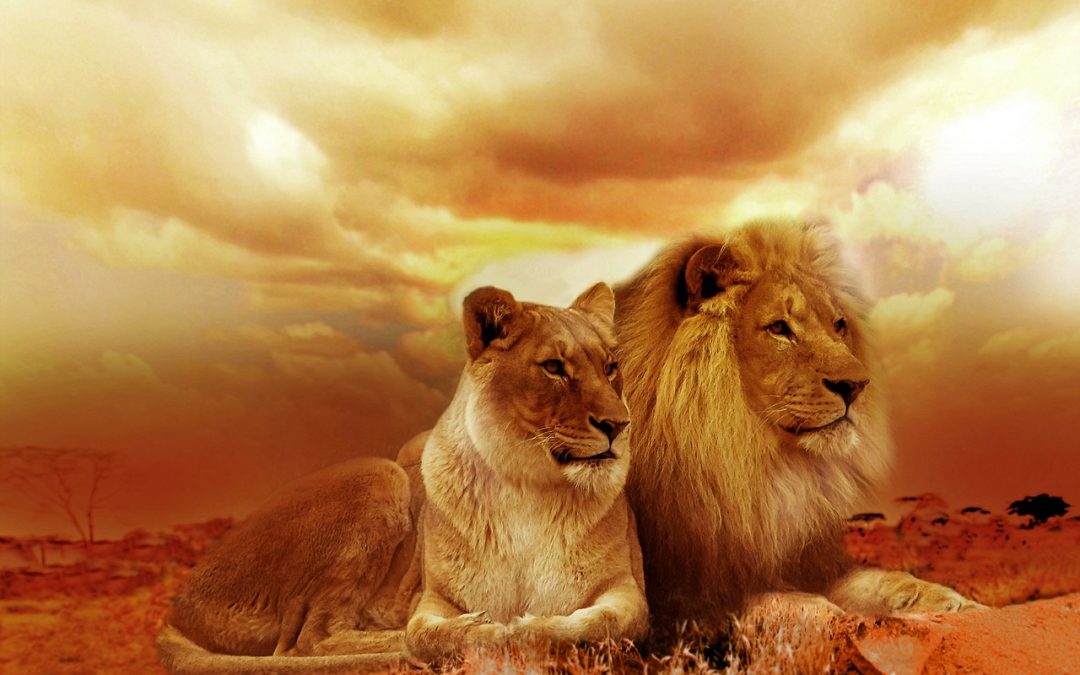
by Somya Devi | Aug 29, 2019 | Astrology, Conjunctions, Events, Holy Days, Planets Changing Signs, Retrograde
Leo New Moon
The Moon is now in the amavasya new Moon phase, waning to total darkness to begin a new lunar cycle tonight at 3:37 am PDT, on August 30th. The Sun and Moon join in sidereal Leo, with Venus, Mars and Mercury all nearby. Sun, Moon and Mercury align with the Vedic nakshatra Magha, “the mighty one,” while Mars and Venus are in Purva Phalguni.
A Leo cycle can bring us in touch with our own inner strength, as Leo is ruled by the Sun and is in essence the royal seat in the zodiac. The Sun’s hot rays work to burn off our impurities, moving us towards our own sattvic nature as is the nature of the Sun. With Mars, Mercury, and Venus all combust as we begin this cycle, Sun is the predominant force in the sky and his message reigns supreme.
His message may be telling you to step into your power and take responsibility over your “dominion.” It could be showing you where you’ve had enough — enough fighting, lusting, or intellectualizing — and need to align with the higher power within. A less intelligent outcome could be a greedy grasping for power, so watch that you pay attention to how you are wielding your energy.
Magha
Magha nakshatra is symbolized by the throne and spans the first 13°20’ of sidereal Leo. We can connect with the inner king of queen from here, and consider the ethics that come with regality. Magha is ruled by the Pitris, the ancestor deities, which indicates this is an important time to connect with your past lineage. The planetary ruler here is Ketu, which also brings in ties to the past and the subconscious. On this dark Moon night, open yourself to dive within and see if there is any inherited karma that is speaking to you or influencing your life now.
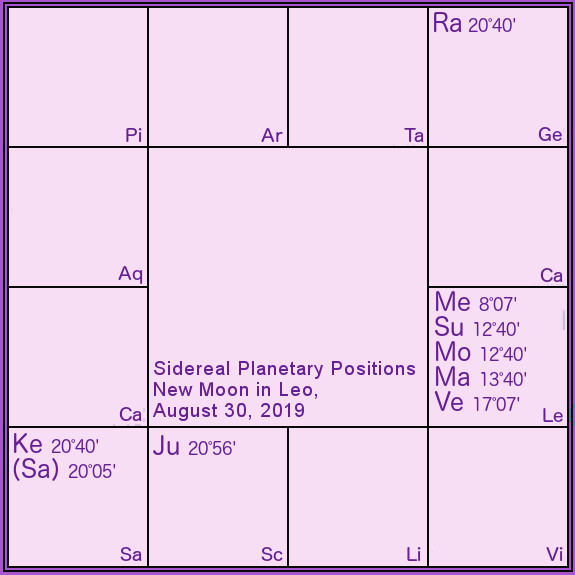
Combust Planets, Wars, & Debilitation
Mars is highly combust — one degree away from the Sun and Moon, while Venus is still slightly combust, within five degrees, and Mercury is within 4. This makes it a challenging time for achieving things ruled by these planets, so it’s not the most auspicious day for beginning new ventures in battles, love or learning.
Mars will be combust within 3 degrees of the Sun from August 24th through September 11th. From September 2-4 Mars and Mercury will go through a planetary war, while being combust at the same time (Mars being exact with the Sun on September 2nd). Again, not the most auspicious days to begin Mars- or Mercury-ruled projects. On September 9th Venus enters Virgo, his sign of debilitation. With Venus here the intellect rules over the desire-body, which can add a scrutinizing or business-like attitude to your romantic endeavors. Mercury and Venus enter a planetary war between September 11th and 15th.
Saturn & Ketu
Saturn and Ketu are coming closer and closer once again, for their third exact conjunction of this year on September 15th (two days after the next full Moon). A few days after that, Saturn will station and go direct on September 18th, while Ketu will continue in his ever-retrograde motion, and the two will finally begin to separate. The last six months may have brought particular challenges in the area of life shown by Sagittarius in your natal chart, or affected you deeply if you have Moon or other prominent placements there.
Ganesh Chaturthi
Jai Ganesha, creator and remover of obstacles! Ganesh Chaturthi will be celebrated on September 2nd, the 4th (chaturthi) waxing Moon phase (tithi) of this lunar cycle. This is an auspicious time to call on the elephant God (if you know him) to help clear a path in your life. Lord Ganesha is also associated with the planet Ketu, the ruler of Magha, where this lunar cycle begins. On Ganesh Chaturthi we can celebrate him through puja and prayer, and it is often customary to build a statue (out of natural clay), for our worship, and then release him into a body of water on the tenth day of prayer.
Personal readings are available and will help to explain how all of these alignments affect your chart and life in particular.









